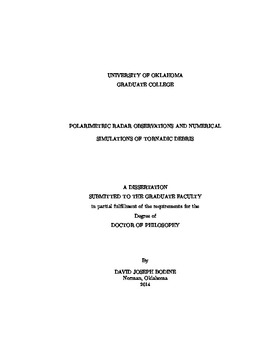| dc.description.abstract | Tornadic debris are critical aspects of tornado studies because airborne debris pose significant threats to life and property, and debris often dominate backscattered radar signals, causing biased Doppler velocity measurements. Polarimetric radar offers new research opportunities because debris produce a unique polarimetric radar signature called the tornadic debris signature (TDS). In this study, new applications of TDSs are examined using Transmission (T) matrix calculations, polarimetric radar observations, and numerical simulations. To illuminate electromagnetic scattering characteristics of different debris types, T-matrix calculations are presented. While most TDS studies have focused on tornado detection, this study conducts a detailed analysis of 14 TDS cases to determine relationships between TDS parameters and EF-rating. As tornado EF-rating increases, 90th percentile radar reflectivity factor, TDS height, and TDS volume increase, and 10th percentile co-polar cross-correlation coefficient and differential reflectivity decrease. While the TDS parameter analysis focuses on a single radar frequency, debris scattering characteristics vary depending on radar frequency, and thus multiple frequency polarimetric radar observations may provide new information about debris. In a statistical analysis of dual-wavelength TDSs,
higher radar reflectivity factor and lower co-polar cross-correlation coefficient are observed at S band compared to C band, and negative differential reflectivity is sometimes observed simultaneously at both frequencies.
Multiple frequency radar observations have additional utility in determining debris concentrations to assess debris loading impacts. To simulate polarimetric radar signatures, tornado vortices are simulated in a Large-Eddy Simulation (LES) model with a drag force coupling parameterization based on debris trajectories, enabling momentum exchange between air and debris. As debris loading increases, simulations reveal decreasing near-surface radial, tangential and vertical velocities in the lowest grid cell. Further increases in debris loading cause greater reductions in near-surface velocities and reduced tornado core tangential and vertical velocities. Using T-matrix calculations and LES model runs, equivalent radar reflectivity factor and two-way attenuation rates are calculated to determine if equivalent radar reflectivity factor or attenuation provide useful upper-bounds on debris loading. These simulations reveal that if sufficient amounts of debris loading are present to affect tornado dynamics, significant attenuation will occur at W band, in many cases fully attenuating the transmitted radar signal. | en_US |
